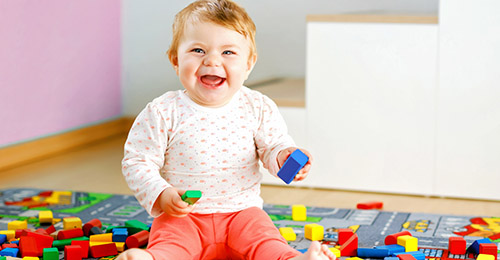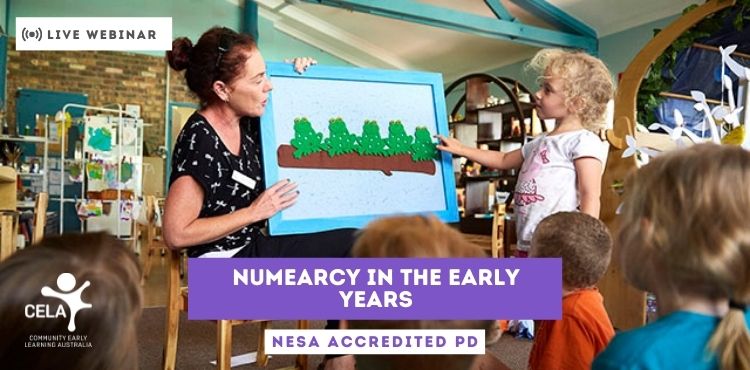By Karthika Viknarasah
Think back to your own childhood. What were your own early experiences of numeracy or mathematics? Were they positive? How do your early mathematical experiences influence the way you teach or include maths and numeracy in your early childhood setting today?
What’s the difference between numeracy and mathematics?
Let's start by taking a closer look at these terms.
According to Australian Curriculum, Assessment and Reporting Authority (ACARA), “Numeracy encompasses the knowledge, skills, behaviours and dispositions that students need to use mathematics in a wide range of situations. It involves students recognising and understanding the role of mathematics in the world and having the dispositions and capacities to use mathematical knowledge and skills purposefully.” (ACARA 2021)
So, mathematics is the abstract study of topics such as numbers, structure and space, while numeracy is the practical, day to day application of mathematical concepts.
How is numeracy approached in the Early Years Learning Framework?
There are many references to numeracy in the Early Years Learning Framework, which include:
-
“Numeracy is the capacity, confidence and disposition to use mathematics in daily life. Children bring new mathematical understandings through engaging with problem solving.” (p. 41)
-
Outcome 3: Children demonstrate spatial awareness and orient themselves, moving around and through their environments, confidently and safely.
-
Outcome 4 : Children create and use representation to organise, record and communicate mathematical ideas and concepts.
-
Outcome 4: Children contribute constructively to mathematical discussions and arguments.
-
Outcome 5 : Children demonstrate an increasing understanding of measurement and number using vocabulary to describe size, length, volume, capacity and names for numbers.
Early numeracy is so much more than recognising numbers and learning to count. Some of the mathematical concepts described in the EYLF include:
- Spatial sense
- Structure and pattern
- Measurement
- Data
- Connections and exploring the world mathematically
How does this apply to very young children and babies?
You may be wondering what kind of mathematics a baby could understand.
At 4 months old a baby realises that two shapes or objects side-by-side are actually separate objects. This is the beginning of one to one correspondence and counting skills.
At 12 months old a child can begin to predict the sequence of events such as the sound of running water in the bathroom means bath time. This is the emergence of an understanding of time and sequence.

Subitising - the foundations for addition and subtraction
Subitising is an important skill that educators can help foster in young children. Subitising is when you are able to look at a group of objects and realise how many there are without counting. This skill helps children to understand what numbers mean or how many ‘things’ a number refers to. It can develop children’s pattern recognition as well as develop cardinality (knowing that the last number-word used in counting determines the total number of items in the set).
By separating and combining numbers through subitising, children lay the foundations for addition and subtraction. It also helps children to understand order irrelevance.
- Using dice, dominoes and cards can help children build subitising skills.
- Using fingers to sing counting rhymes or play games as well as games involving hidden items can also help foster subitising skills.

Introducing numeracy through music and movement
Another great way that mathematics can be included in an early learning setting is through music and movement. Probably the closest connection between music and maths is that they both use patterns.
Music has repeating choruses and sections of songs and in maths patterns are used to explain and predict the unknown. Research also shows that children who learn their academics through music retain the information better than those who learn the same concepts by verbal instruction. It is also easier to remember information when it is put into a rhyme or song (Elofssonet al. 2018; Holmes & Hallam, 2017).
Think of the hand washing song that you might use in your own setting.
Why use a song?
Because it facilitates memory and sequencing. You might have other processes that you have set to music.
Making mathematical learning visible to families
By making mathematical learning visible to families when we communicate our program with them, we can help families to see how easily numeracy skills can be included as part of day to day activities.
For example, explaining the mathematical learning that is taking place during a cooking experience such as measuring, estimating, volume and time, can help families to understand how they can practice these skills at home as well. Educators can also discuss with families the importance of talking children through these experiences and helping children to recognise these concepts while they are participating in order to help cement their understanding.

Why it’s important for early educators to be mathematically proficient
Being proficient and confident with maths lays the foundation for lifelong learning. As children become more numerate and experience feelings of success and even joy in their early mathematical experiences, they gain confidence as learners. This intrinsic motivation can encourage children to challenge themselves even further.
In order for us to be able to teach mathematical concepts in a play based setting, we need to be knowledgeable and comfortable with using mathematics in our everyday lives and applying numeracy in early childhood settings.
References:
ACARA. (2021). Retrieved 6 July 2021, from https://www.acara.edu.au/
Good, S. C., & Ottley, J. R. (2019). Learning Mathematics through Everyday Play Activities. YC Young Children, 74(3), 73-78.
Elofsson, J., Englund Bohm, A., Jeppsson, C., & Samuelsson, J. (2018). Physical activity and music to support pre-school children’s mathematics learning. Education 3-13, 46(5), 483-493.
Holmes, S., & Hallam, S. (2017). The impact of participation in music on learning mathematics. London Review of Education, 15(3), 425-438.
Pixner, S. , Kraut, C. and Dresen, V. (2017) Early Predictors for Basic Numerical and Magnitude Competencies in Preschool Children—Are They the Same or Different regarding Specific Subgroups?. Psychology, 8, 271-286. doi: 10.4236/psych.2017.82016
Would you like to know more about this topic?

About Karthika
Karthika had a successful career as an accountant before following her passion to the early childhood sector. She has worked as an Educator, Early Childhood Teacher and Director in long day care and OOSH services. She holds a Master of Teaching degree and a Master of Educational Leadership degree and is a NESA Early Childhood Teacher Accreditation Supervisor.
In her work with CELA she uses her specialist qualifications and experience to undertake compliance audits for services as well as facilitating training to support sector professionals pursuing continuous improvement. Karthika is passionate about the performing arts as a conduit for holistic development with a particular emphasis on early literacy and speech development.